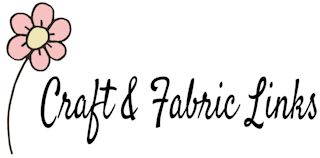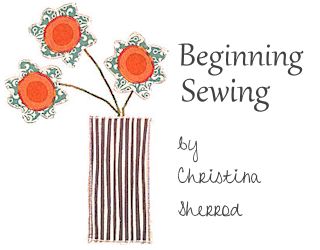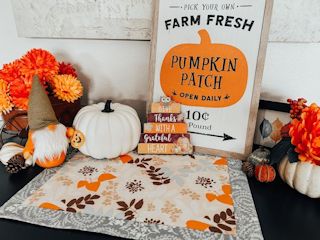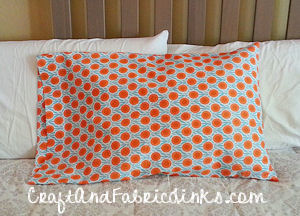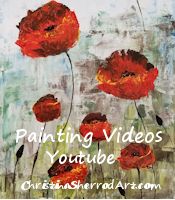| HOME SEW CRAFTS DECOR SHOP |
Free Sewing BookSewing Lessons For BeginnersChapter 2: Choosing Pattern, Fabric, Notions & Thread |

|
|
|
-> table of contents
|
Articles, images and patterns © Christina Sherrod of CraftAndFabricLinks.com unless otherwise noted.
|
|
In choosing fabric, remember your project. Is this fabric appropriate for what you are making? "Test" the fabric. Drape it over your arm and watch how it falls. A dress fabric should drape nicely. A fabric for a tote bag should be stiffer. Scrunch it up into a ball and then let it go. Does it wrinkle easily? Don't forget fabric care. A fabric that requires dry cleaning would not be appropriate for towel trim, for example. Refer to the back of your project's pattern envelope for fabric suggestions. See Chapter 3 for more information on reading pattern cover backs. There is usually some choice in fabrics, but do not choose a fabric that the pattern specifically says not to use. Do you have experience with this type of fabric? Will your machine handle it well? Although stretch knits are wonderful to use with sergers, they are difficult to work with on a regular sewing machine (unless your machine has stretch stitch capability). Texture should be considered. If the fabric will be used for clothing, is it comfortable against the skin? Pattern instructions (or the back of the pattern cover) will state required yardage. Remember that patterns do not allow for shrinkage when stating quantity of fabric to purchase. For fabrics that shrink, buy a bit extra to allow for the shrinkage. If you are tall, you will need to add to the pattern length, which will require more fabric. Plaids and directional prints also require extra yardage, because fabric is wasted in the process of matching the fabric. ALWAYS pre-wash your fabric (if it is washable). Dry clean the fabric if that is the required method of cleaning. This is not a place to cut corners! What a shame it would be to make a wonderful skirt that has a perfect fit, only to have it shrink in the wash! One of the benefits of sewing is that you can prevent this problem. If the fabric comes out wrinkled, a good ironing will make it easier to work with. Pre-washing also removes any sizing and other additives on the fabric. Sizing can cause problems with sewing machines (skipped stitches). Sizing is usually found on inexpensive fabrics (see note below). Another reason to pre-shrink fabric before sewing is that fabric can pucker around stitches if it shrinks after it has been stitched. NOTE: Beware of inexpensive fabrics that have been treated to make them seem like higher quality fabric. Sizing is an additive (usually a trype of starch) that is sprayed onto fabric to give it body and weight. It is temporary (washes off). An inexpensive fabric treated with sizing might feel and behave like a higher quality fabric, but after washing it will be limp and without body. I sometimes use inexpensive quilt fabric for wall hangings and pieces that I do not intend to wash. For anything else, they are not the good buy they appear to be. The weave of inexpensive fabric is looser than that of high quality fabric. Hold up a piece of good quality quilt fabric and compare it to a piece of inexpensive fabric. Do you see through the inexpensive fabric? What about the name brand quilt fabric? See the difference? The biggest difference is seen after washing.
Pattern Selection
Choosing a pattern goes along with choosing your fabric, so don't purchase one until you have chosen the other. CraftAndFabricLinks.com has wonderful patterns for beginners. Best of all, they are free! Other sites have very good patterns as well. For a complete selection of my FREE patterns, go to: Free Sewing Patterns I recommend a non-clothing item as your first project. Getting clothing to fit is a skill by itself and may be a bit much as a first project. For your first project, you will be getting to know your machine, getting familiar with various stitches and cutting techniques and learning to guide your fabric through the machine - not to mention learning to sew a straight line. That is enough without the added complications of fitting a pattern to your body! In past sewing classes, I have used the easy tote bag pattern for beginners. It is a fun, practical item to make. If your first project is clothing, be sure to measure carefully. It is better to choose a pattern that is a little too large, rather than too small. This is because you can always take in the waist and make other adjustments. Notions
Refer to Chapter Six: Interfacing for more information on interfacing.
Thread
As with fabric and notions, consider your project. Some threads need do be dry cleaned. Others can be machine washed. Extra fine thread is good for lightweight fabrics or machine embroidery. use heavier threads for heavy fabrics, such as upholstery fabric. Mercerized cotton has no stretch so should only be used for fabrics that have no stretch. I use polyester or cotton covered polyester for most of my projects. All purpose thread serves most fabric weights. Denim would require a heavier weight thread and silks and finer fabrics require a lighter weight thread. In choosing the color, the general rule is to choose one shade darker than your fabric, unless you feel you can get a perfect match. For topstitching and decorative stitching, you can choose a contrasting color. Refer to the Thread and Needle Chart at the end of this book for information on choosing the proper thread. |
Quick Reference |
Learn To Paint!free video tutorialsVisit my youtube channel. Free videos with step by step instructions. Paint beautiful paintings for your home. |
Please ShareI rely on advertising to keep my site free. Please share with friends. |
Privacy Policy & Terms Of UseBy using our website, you expressly consent to our Privacy Policy and Terms & Conditions. All Patterns, images and instructions are copyright protected. |
